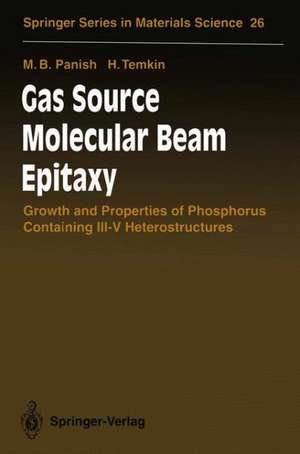Gas Source Molecular Beam Epitaxy: Growth and Properties of Phosphorus Containing III-V Heterostructures: Springer Series in Materials Science, cartea 26
Autor Morton B. Panish, Henryk Temkinen Limba Engleză Paperback – 30 dec 2011
Din seria Springer Series in Materials Science
- 18%
 Preț: 1820.22 lei
Preț: 1820.22 lei - 18%
 Preț: 776.09 lei
Preț: 776.09 lei - 24%
 Preț: 689.69 lei
Preț: 689.69 lei - 18%
 Preț: 968.96 lei
Preț: 968.96 lei - 20%
 Preț: 568.95 lei
Preț: 568.95 lei - 18%
 Preț: 953.65 lei
Preț: 953.65 lei - 18%
 Preț: 902.36 lei
Preț: 902.36 lei - 18%
 Preț: 953.65 lei
Preț: 953.65 lei - 20%
 Preț: 948.42 lei
Preț: 948.42 lei - 18%
 Preț: 1143.07 lei
Preț: 1143.07 lei - 18%
 Preț: 1111.53 lei
Preț: 1111.53 lei - 18%
 Preț: 1103.62 lei
Preț: 1103.62 lei - 18%
 Preț: 1225.94 lei
Preț: 1225.94 lei -
 Preț: 473.91 lei
Preț: 473.91 lei - 18%
 Preț: 782.42 lei
Preț: 782.42 lei -
 Preț: 433.47 lei
Preț: 433.47 lei - 18%
 Preț: 1116.40 lei
Preț: 1116.40 lei - 18%
 Preț: 946.24 lei
Preț: 946.24 lei - 18%
 Preț: 945.20 lei
Preț: 945.20 lei - 18%
 Preț: 1114.21 lei
Preț: 1114.21 lei - 15%
 Preț: 641.20 lei
Preț: 641.20 lei - 18%
 Preț: 958.56 lei
Preț: 958.56 lei - 18%
 Preț: 1224.36 lei
Preț: 1224.36 lei - 15%
 Preț: 644.82 lei
Preț: 644.82 lei - 24%
 Preț: 833.45 lei
Preț: 833.45 lei - 24%
 Preț: 1060.36 lei
Preț: 1060.36 lei - 18%
 Preț: 964.10 lei
Preț: 964.10 lei - 18%
 Preț: 1224.36 lei
Preț: 1224.36 lei - 18%
 Preț: 1221.20 lei
Preț: 1221.20 lei - 18%
 Preț: 946.87 lei
Preț: 946.87 lei - 18%
 Preț: 1836.92 lei
Preț: 1836.92 lei - 15%
 Preț: 643.34 lei
Preț: 643.34 lei - 18%
 Preț: 1246.32 lei
Preț: 1246.32 lei - 18%
 Preț: 956.81 lei
Preț: 956.81 lei - 18%
 Preț: 953.52 lei
Preț: 953.52 lei - 15%
 Preț: 637.59 lei
Preț: 637.59 lei
Preț: 647.40 lei
Preț vechi: 761.65 lei
-15% Nou
Puncte Express: 971
Preț estimativ în valută:
123.87€ • 129.35$ • 102.29£
123.87€ • 129.35$ • 102.29£
Carte tipărită la comandă
Livrare economică 15-29 aprilie
Preluare comenzi: 021 569.72.76
Specificații
ISBN-13: 9783642781292
ISBN-10: 3642781292
Pagini: 444
Ilustrații: XIV, 428 p.
Dimensiuni: 155 x 235 x 23 mm
Greutate: 0.61 kg
Ediția:Softcover reprint of the original 1st ed. 1993
Editura: Springer Berlin, Heidelberg
Colecția Springer
Seria Springer Series in Materials Science
Locul publicării:Berlin, Heidelberg, Germany
ISBN-10: 3642781292
Pagini: 444
Ilustrații: XIV, 428 p.
Dimensiuni: 155 x 235 x 23 mm
Greutate: 0.61 kg
Ediția:Softcover reprint of the original 1st ed. 1993
Editura: Springer Berlin, Heidelberg
Colecția Springer
Seria Springer Series in Materials Science
Locul publicării:Berlin, Heidelberg, Germany
Public țintă
ResearchCuprins
1. Introduction.- 1.1 Introduction to Molecular Beam Epitaxy.- 1.2 Introduction to Gas Source Molecular Beam Epitaxy.- 1.3 Why Gas Sources?.- 1.4 Heterostructures with GSMBE.- 2. Chemistry.- 2.1 Equilibrium, the Phase Diagram, and Molecular Beam Epitaxy.- 2.2 Liquid-Solid-Vapor Relationships for the Growth of InP and GaAs.- 2.3 III-V Solid Solutions.- 2.4 Group III Metalorganics — Metalorganic MBE.- 2.5 Group V Metalorganics to Replace Arsine and Phosphine.- 3. The Generation of Atomic and Molecular Beams for Elemental and Gas Source Molecular Beam Epitaxy.- 3.1 Background.- 3.2 Molecular Effusion: The Ideal Effusion Cell.- 3.3 Real Effusion Cells.- 3.4 Gas Sources and Their Use in GSMBE.- 3.5 Introduction of the Group III Metalorganics into the MBE System.- 4. Molecular Beam Epitaxy Systems and Procedures.- 4.1 The Conventional Growth Chamber-Configuration for ESMBE, HSMBE and MOMBE.- 4.2 System Pressure — Pumping.- 4.3 Sample Introduction, Transfer and Manipulation.- 4.4 Substrate Temperature Measurement and Control.- 4.5 Gas Handling.- 4.6 Arsine and Phosphine Generators.- 4.7 Safe Handling of Arsine and Phosphine for GSMBE.- 4.8 Procedures for GSMBE.- 4.9 The RHEED Apparatus, Growth Rate and Composition Calibration.- 4.10 Metalorganic MBE Systems — Potential for Scaleup.- 5. Doping During GSMBE.- 5.1 Background.- 5.2 Maximum Free-Carrier Concentrations in Semiconductors.- 5.3 Background Doping and Carbon Incorporation.- 5.4 Doping with Tin.- 5.5 Doping with Be.- 5.6 Zn in InP and GaInAs.- 5.7 Si in GaAs, InP and GaInAs.- 5.8 Semi-insulating InP by Fe Doping During MBE.- 6. Characterization of Heterostructures by High Resolution X-ray Diffraction.- 6.1 X-Ray Diffraction of Epitaxial Layers.- 6.2 Periodic Epitaxial Semiconductor Structures.- 6.3 High-ResolutionX-Ray Diffraction.- 6.4 High-Resolution Rocking Curves of Superlattices.- 6.5 Intrinsic Strain at Heterostructure Interfaces.- 7. Optical Properties of Quantum Wells.- 7.1 Energy Levels in Quantum Wells.- 7.2 Single Quantum Wells.- 7.3 Superlattices.- 7.4 Quantum Wires and Boxes.- 7.5 Electric Field Effects.- 7.6 Strained-Layer Superlattices.- 7.7 Thermal Stability.- 8. Carrier Transport Across Quantum Wells and Superlattices.- 8.1 Experimental Techniques.- 8.2 Motion of Photo-Induced Holes.- 8.3 Sequential Screening.- 8.4 Barrier Height.- 8.5 Heterojunction Band Offsets.- 8.6 Telegraph Noise.- 9. Bipolar Transistors.- 9.1 Background.- 9.2 Figures of Merit.- 9.3 Device Fabrication.- 9.4 DC Characteristics.- 9.5 Temperature Dependence.- 9.6 Carrier Transport.- 9.7 Gain Dependence on the Base Thickness.- 9.8 Microwave Devices.- 9.9 Applications.- 10. Optoelectronic Devices.- 10.1 Broad-Area Lasers.- 10.2 Buried Heterostructure Lasers.- 10.3 Single-Frequency Lasers.- 10.4 Visible Lasers.- 10.5 Photodetectors.- 10.6 Quantum-Well Inter-sub-band Detectors.- 11. In-Situ Processing and Selective Area Epitaxy.- 11.1 Pattern Formation.- 11.2 Ion-Induced Damage.- 11.3 Towards Vacuum Lithography.- 11.4 Buried Heterostructures.- 11.5 Selective-Area Epitaxy.- References.











